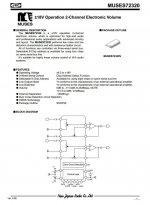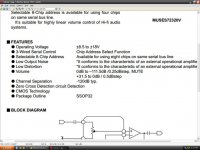As -111.5 to 0db at .25db steps plus mute= (111.5*4)+1= 447 steps
Then 0db to 31.5db at .5db steps= 2*31.5= 63 steps.
I read this as a total of 510 steps. 😉
I like .25db steps better.
But, I would like to see a device that has .1db steps throughout the range instead.
jer 🙂
Then 0db to 31.5db at .5db steps= 2*31.5= 63 steps.
I read this as a total of 510 steps. 😉
I like .25db steps better.
But, I would like to see a device that has .1db steps throughout the range instead.
jer 🙂
Last edited:
.25db steps is way too small. I have attens that use half db steps and THAT is often too small of a change.
.25db per step means that you have to allocate more digits on a display to show it, more update chars (slower to display), more math to be done during the display and worst of all, you can't fit it all in a single 256-step byte. I really like being able to keep the volume setting in an 8bit byte.
just because an engine can go down to .25db is not a good enough reason to implement it that way, at the application layer.
fwiw...
.25db per step means that you have to allocate more digits on a display to show it, more update chars (slower to display), more math to be done during the display and worst of all, you can't fit it all in a single 256-step byte. I really like being able to keep the volume setting in an 8bit byte.
just because an engine can go down to .25db is not a good enough reason to implement it that way, at the application layer.
fwiw...
".25db per step means that you have to allocate more digits on a display to show it, more update chars (slower to display)"
Yes, This is my thought too and is why I suggested .1db steps instead. 🙂
jer 🙂
Yes, This is my thought too and is why I suggested .1db steps instead. 🙂
jer 🙂
.1db is going to make you turn the knob SO MUCH, it will annoy you.
I built a .1db attenuator (using my relay atten circuit, 8 relays giving me about 32db of total range). the intention was not to vary it for program material but to use it as a 'trimmer box' to match levels with my subwoofer and the mains. set it once and forget it, but I needed fine db spacing since you do notice small changes with subwoofers.
regular daily use of vol controls would make you hate having .1db steps.
I strongly advise against it.
or, have some mode where you can adjust down to .1, but for daily use, half or even 1db is really all you need to do the daily ups and downs 😉
I built a .1db attenuator (using my relay atten circuit, 8 relays giving me about 32db of total range). the intention was not to vary it for program material but to use it as a 'trimmer box' to match levels with my subwoofer and the mains. set it once and forget it, but I needed fine db spacing since you do notice small changes with subwoofers.
regular daily use of vol controls would make you hate having .1db steps.
I strongly advise against it.
or, have some mode where you can adjust down to .1, but for daily use, half or even 1db is really all you need to do the daily ups and downs 😉
I was searching for some digital pots today and I could only find three types that are +/- 15V capable for use in EQ's, Crossover filters and tone controls all the others can only handle no more the 5 or 6 volts beides some of TI's PGA parts.
Analog devices has Three different types that are good for +/- 16.5V.
One has 256 steps and two types that are 1024 steps,
http://www.analog.com/static/imported-files/data_sheets/AD5291_5292.pdf
http://www.analog.com/static/imported-files/data_sheets/AD5293.pdf
Microchip has one part that is good for +/-18v and it is a 7/8bit device,
http://ww1.microchip.com/downloads/en/DeviceDoc/20005207A.pdf
The THD for the AD devices are very low at -106db or .0005% THD.
They can be a bit pricey at $3.65 to $9 per part at mouser depending on which one you choose as this is typical.
Or you could get them for about 1/2 to 1/3 that for 100 of them straight from Analog Devices ranging from $2.29 to $4.59 each.
Microchip doesn't list the data for THD But I would expect similar results.
The microchip part is only $1.37 at the microchip store for just one part.
They are all single channel devices and they typically don't cost anymore than, if not cheaper than, a regular high quality mechanical pot would cost in single units.
However these do require an MCU to control them.
jer 🙂
Analog devices has Three different types that are good for +/- 16.5V.
One has 256 steps and two types that are 1024 steps,
http://www.analog.com/static/imported-files/data_sheets/AD5291_5292.pdf
http://www.analog.com/static/imported-files/data_sheets/AD5293.pdf
Microchip has one part that is good for +/-18v and it is a 7/8bit device,
http://ww1.microchip.com/downloads/en/DeviceDoc/20005207A.pdf
The THD for the AD devices are very low at -106db or .0005% THD.
They can be a bit pricey at $3.65 to $9 per part at mouser depending on which one you choose as this is typical.
Or you could get them for about 1/2 to 1/3 that for 100 of them straight from Analog Devices ranging from $2.29 to $4.59 each.
Microchip doesn't list the data for THD But I would expect similar results.
The microchip part is only $1.37 at the microchip store for just one part.
They are all single channel devices and they typically don't cost anymore than, if not cheaper than, a regular high quality mechanical pot would cost in single units.
However these do require an MCU to control them.
jer 🙂
Microchip just released their line of 36v digital pots today!!!!!
Microchip Technology Inc. - Industry?s 1st 5 kohm DigiPots With Specified 36V Operating Voltage; Support Wide Signal Swings
http://ww1.microchip.com/downloads/en/DeviceDoc/20005304A.pdf

jer 🙂
Microchip Technology Inc. - Industry?s 1st 5 kohm DigiPots With Specified 36V Operating Voltage; Support Wide Signal Swings
http://ww1.microchip.com/downloads/en/DeviceDoc/20005304A.pdf

jer 🙂
linear 'taper' or log?
linear is not what you want for audio, of course.
is there zero-crossing detection? its also what you want for live audio.
(no, I did not read the press. too lazy) 😉
linear is not what you want for audio, of course.
is there zero-crossing detection? its also what you want for live audio.
(no, I did not read the press. too lazy) 😉
- Status
- Not open for further replies.
- Home
- Source & Line
- Digital Line Level
- DIY volume control open-source project

